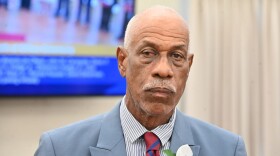ST. CROIX — Public trees along the roads are getting cut down on St. Croix despite a law enacted six years ago to protect them.
The establishment of a Tree Board and a focus on public education, however, are crucial steps in preserving the territory’s urban tree canopy and ensuring compliance with a law that has been on the books since January 6, 2019, the Community and Heritage Tree Law of the Virgin Islands.
“There’s a great need for education when it comes to the care of our trees, and not in every case a tree has to be removed,” Agriculture Commissioner Louis Petersen Jr. said. “In some cases, proper pruning would improve the health of the tree but also safeguard us from the damages of trees or parts of trees falling on wires and utilities.”
Petersen said the Virgin Islands Department of Agriculture intends to conduct training in both districts through its Forestry Division with the support of the University of the Virgin Islands, School of Agriculture. He said the training must be continuous to teach proper pruning techniques.
“When I look around and see trees, how they have been pruned, there’s an obvious need for the training,” he said.
The Virgin Islands Water and Power Authority partnered with the UVI Center for Excellence in Leadership & Learning in October to launch a series of tree pruning workshops for WAPA linemen to enhance their expertise as part of an initiative that built on previous sessions with certified arborists.
A pair of trees under power lines along Queen Mary Highway across from the old HH Tire identified by environmentalist and UVI assistant professor Olasee Davis as a flamboyant and thibet were cut down in September.

WAPA’s spokesperson said the Authority was not involved with the removal of those trees. When WAPA crews prune trees growing into power lines, they only trim below the power lines, Shanell Petersen, WAPA spokesperson, said.
“We don’t cut to the stump; that’s not something that the line crews would do,” she said. “It may be something that the contractor would do, but I’m pretty sure that that’s still not the case.”
James Bates, owner of Bates Trucking and Trash Removal, said he assisted in the removal of both trees.
“The trees were catching fire in the power lines,” he said.
Although the trees were penetrating the power lines, Davis said there was no need to remove them.
“Those trees could be pruned in such a way they would not touch the power line, so that’s not an excuse,” he said.
Vanessa Forbes, a trained arborist, agreed with Davis, noting the roots of those trees absorbed water that tends to pond in that area. Now that the trees are gone, she said the water will remain stagnant and attract mosquitoes, which she noted carry disease.
“The branches could have been reduced properly if they had reached out to an arborist,” Forbes said. “There are several arborists within the territory.”
A pair of trees were also cut down along Queen Mary Highway near Barron Spot Village Mall in October.

Shanell Petersen acknowledged the removal of both of those trees following Tropical Storm Ernesto, which struck the territory on the night of August 13.
“Between DPW and I think we had another contractor, that may have happened,” she said. “And maybe that’s something where we need to have more conversations with agencies that support during emergency times.”
Public Works Commissioner Derek Gabriel said he was not familiar with the removal of those trees. He did explain that three mahogany trees got cut down along Queen Mary Highway at the entrance to The Market, formerly Plaza West, in October following numerous complaints in the aftermath of traffic accidents that were supported by police reports. He said the supermarket owners were among those who contacted DPW.
“A number of people have reached out, and so we wanted to remove those visual impediments,” Gabriel said.

Ariela Hayes, who has discussed the removal of trees on her WSTX AM 970 radio program, “Arise,” said there should be more effort among government agencies to preserve trees instead of cutting them down, especially considering the Community and Heritage Tree Law has been on the books for six years.
“One thing growing up we always knew is you don’t cut down mahogany trees,” she said. “And so now, with all this cutting down of the mahogany trees, how has this law been forgotten? Why is it not being honored?”
Gabriel said a lot of the mahogany trees were historically planted along major roads because they provided shade for horses and buggies that would traverse between the towns.
“The tree systems that were planted over 100 years ago in some instances are now causing more damage to our infrastructure than providing benefit to the community, so I think there’s a larger discussion that needs to happen about the type of trees that people plant,” he said.
Gabriel said mahogany trees have a robust root system that can cause major damage to cisterns, drainage culverts along roads, and even tombs in cemeteries.
“In some of the cemeteries, we’re actually removing mahogany trees because the growth of the root systems are causing the tombs to be lifted out of the ground, so there are certain instances where it’s beyond pruning,” he said, particularly noting Western Cemetery on St. Thomas.
Mary Roebuck, a multigenerational Crucian whose family roots date back more than 200 years, spoke of her connection to the environment and her volunteer work with the St. Croix Hiking Association and Virgin Islands Trail Alliance while noting the importance of preserving trees. She suggested having community input before trees get removed.
“Maybe people can come up with ideas to have a different resolution other than cutting them down,” she said. “Let the cutting be the last option where there’s no other way.”
Public notice posted near a street, published in a newspaper, and broadcasted on the radio as well as public hearings are required by law before removal of a tree. The Tree Board, which has not yet been implemented, must hold a public hearing at least 14 days prior to the tree removal.
Government entities are not the only responsible parties when it comes to removal of trees, or improper pruning.
Forbes said a private landowner poisoned four mahogany trees on the roadside next to the Virgin Islands Police Department’s Commissioner Office on the corner of Hope Road and 24th Boulevard (Route 81) in Estate Castle Coakley.
“Those trees were killed,” she said, noting the trunks turned white because they were poisoned. “I can show holes dug into the trees to inject restricted-use pesticide.”

Forbes noted the need for education on the law.
A permit must be obtained from the Department of Agriculture for all types of work or treatments to public trees, including removal and pruning. Crews of the Water and Power Authority and Department of Public Works, or their subcontractors, are permitted to prune or remove public trees as needed to maintain properly functioning public infrastructure, such as roads, sidewalks, overhead utilities, or buried utilities. A member of the crew, however, must be a certified arborist, or the crew must have an arborist supervise the work. A tree pruning permit is not required when a tree comes in direct contact with public infrastructure, such as overhead power lines, any circumstance that represents an immediate hazard to public safety, or during a state of emergency when emergency work is required.
Regina Keels, a member of the St. Croix Hiking Association, said her late father, Andrew Edwards, planted mahogany trees on his property the year she was born, and only one remains standing.
“Replacing the trees are also important, not just protecting the ones that are here, but also replanting,” she said. “And I know that there have been other efforts to replant trees, and that’s something that we need to do.”
Replanting trees that get cut down is required by law.
When a public tree is removed, a replacement tree must be planted that is the largest available of the same or similar species, or another suitable species.
The Community and Heritage Tree Law, Act No. 8149 (Bill No. 32-0062), came about through the advocacy of conservationists and those concerned with the loss of historic and landmark trees in the Virgin Islands, former Senator Myron Jackson, who sponsored the legislation, said. He noted how trees were “destroyed” along Queen Mary Highway during the recovery following the hurricanes of 2017 because an arborist was not involved in the pruning.
“We don’t want to repeat that again and if we don’t learn from the past, that’s exactly what is going to happen,” he said. “We see every day in this territory a blatant disrespect for trees.”
Jackson said the tree law is a guide, stressing that it must evolve for the needs of the community while also providing a measure of protection.
“There is value to a tree, and there’s value to heritage trees that have been in the landscape before we were born and will be here long after we’re gone, but if we don’t protect them, then there is no heritage to protect,” he said.
Even with the law in place, Virgin Islanders are continuing their advocacy to protect the trees.
Three months ago, Keels created an online version of a petition Forbes originally circulated in person that has 60 verified signatures. Keels spoke about the purpose of the online petition to “Save the Trees of St. Croix.”
“We’re hoping that more people will sign it, and we would get some public support for protecting trees, especially the mahogany trees and other old trees on the island,” she said.
The petition notes that the 32nd Legislature of the Virgin Islands passed the Community and Heritage Tree Law to protect and preserve trees, yet the law is not being administered as no members have been appointed to the Tree Board.
Louis Petersen, who is responsible for appointing members to the Tree Board in his capacity as territorial forester, acknowledged that the Tree Board is not in place but noted the existence of a Tree Council. When the Tree Council meets on Thursday, December 12, he said the agenda will include a request for its members to suggest to him a slate of candidates to serve on the Tree Board.
“What I expect to come out of that meeting is a slate for me to consider,” the commissioner said. “And then from there, we’ll have the board established so they can start enforcing the laws.”















